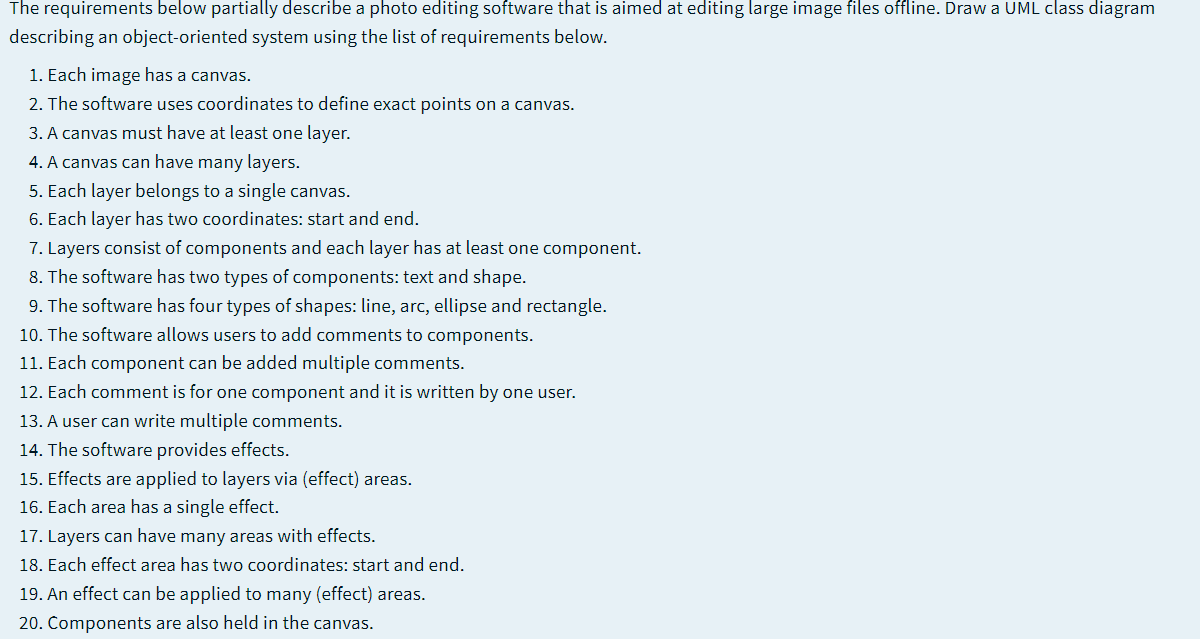at editing large Ima requirements below partially describe a photo editing software escribing an object-oriented system using the list of requirements below. 1. Each image has a canvas. 2. The software uses coordinates to define exact points on a canvas. 3. A canvas must have at least one layer. 4. A canvas can have many layers. 5. Each layer belongs to a single canvas. 6. Each layer has two coordinates: start and end. 7. Layers consist of components and each layer has at least one component. 8. The software has two types of components: text and shape. 9. The software has four types of shapes: line, arc, ellipse and rectangle. 10. The software allows users to add comments to components. 11. Each component can be added multiple comments. 12. Each comment is for one component and it is written by one user. 13. A user can write multiple comments. 14. The software provides effects. 15. Effects are applied to layers via (effect) areas. 16. Each area has a single effect. 17. Lavers can have many areas with effects.
at editing large Ima requirements below partially describe a photo editing software escribing an object-oriented system using the list of requirements below. 1. Each image has a canvas. 2. The software uses coordinates to define exact points on a canvas. 3. A canvas must have at least one layer. 4. A canvas can have many layers. 5. Each layer belongs to a single canvas. 6. Each layer has two coordinates: start and end. 7. Layers consist of components and each layer has at least one component. 8. The software has two types of components: text and shape. 9. The software has four types of shapes: line, arc, ellipse and rectangle. 10. The software allows users to add comments to components. 11. Each component can be added multiple comments. 12. Each comment is for one component and it is written by one user. 13. A user can write multiple comments. 14. The software provides effects. 15. Effects are applied to layers via (effect) areas. 16. Each area has a single effect. 17. Lavers can have many areas with effects.
Computer Networking: A Top-Down Approach (7th Edition)
7th Edition
ISBN:9780133594140
Author:James Kurose, Keith Ross
Publisher:James Kurose, Keith Ross
Chapter1: Computer Networks And The Internet
Section: Chapter Questions
Problem R1RQ: What is the difference between a host and an end system? List several different types of end...
Related questions
Question
Draw a UML Class diagram with the following requirements

Transcribed Image Text:The requirements below partially describe a photo editing software that is aimed at editing large image files offline. Draw a UML class diagram
describing an object-oriented system using the list of requirements below.
1. Each image has a canvas.
2. The software uses coordinates to define exact points on a canvas.
3. A canvas must have at least one layer.
4. A canvas can have many layers.
5. Each layer belongs to a single canvas.
6. Each layer has two coordinates: start and end.
7. Layers consist of components and each layer has at least one component.
8. The software has two types of components: text and shape.
9. The software has four types of shapes: line, arc, ellipse and rectangle.
10. The software allows users to add comments to components.
11. Each component can be added multiple comments.
12. Each comment is for one component and it is written by one user.
13. A user can write multiple comments.
14. The software provides effects.
15. Effects are applied to layers via (effect) areas.
16. Each area has a single effect.
17. Layers can have many areas with effects.
18. Each effect area has two coordinates: start and end.
19. An effect can be applied to many (effect) areas.
20. Components are also held in the canvas.
Expert Solution
This question has been solved!
Explore an expertly crafted, step-by-step solution for a thorough understanding of key concepts.
Step by step
Solved in 2 steps with 1 images

Recommended textbooks for you

Computer Networking: A Top-Down Approach (7th Edi…
Computer Engineering
ISBN:
9780133594140
Author:
James Kurose, Keith Ross
Publisher:
PEARSON

Computer Organization and Design MIPS Edition, Fi…
Computer Engineering
ISBN:
9780124077263
Author:
David A. Patterson, John L. Hennessy
Publisher:
Elsevier Science

Network+ Guide to Networks (MindTap Course List)
Computer Engineering
ISBN:
9781337569330
Author:
Jill West, Tamara Dean, Jean Andrews
Publisher:
Cengage Learning

Computer Networking: A Top-Down Approach (7th Edi…
Computer Engineering
ISBN:
9780133594140
Author:
James Kurose, Keith Ross
Publisher:
PEARSON

Computer Organization and Design MIPS Edition, Fi…
Computer Engineering
ISBN:
9780124077263
Author:
David A. Patterson, John L. Hennessy
Publisher:
Elsevier Science

Network+ Guide to Networks (MindTap Course List)
Computer Engineering
ISBN:
9781337569330
Author:
Jill West, Tamara Dean, Jean Andrews
Publisher:
Cengage Learning

Concepts of Database Management
Computer Engineering
ISBN:
9781337093422
Author:
Joy L. Starks, Philip J. Pratt, Mary Z. Last
Publisher:
Cengage Learning

Prelude to Programming
Computer Engineering
ISBN:
9780133750423
Author:
VENIT, Stewart
Publisher:
Pearson Education

Sc Business Data Communications and Networking, T…
Computer Engineering
ISBN:
9781119368830
Author:
FITZGERALD
Publisher:
WILEY